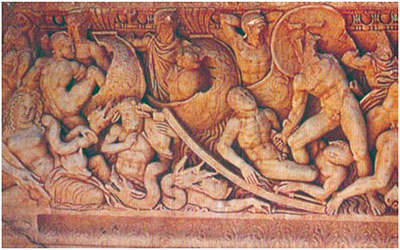A city in the center of the Orontes Valley located on a mound 20 km north of Homs. It is an ancient city that belongs to the second half of the second millennium BC. A Hieroglyphic – Hittite board was discovered in it bearing the name of Arkholetti Bin Toui, king of Hama. The city prospered during the Aramaic Hellenistic eras and during the Roman age it was ruled by an Arab clan called Shmsigram and became an important cultural center, evidences of which are the mosaics and sarcophaguses discovered lately in it.
In the Byzantine period it was named Larissa II with houses built of basalt and lime stones.
AlRastan, (Arithoza), was the main city in the region and one of several cities built by Silicus Nicator. Because it looked like Arithoza, a river spring south of Greece, it was named after it.
The city was well organized with two main crossing streets and a huge wall. Excavations today revealed many cemeteries and sarcophaguses- two of them are in the National Museum in Damascus with a statue of Aphrodite bathing.
North of al Rastan a dam was built on the Orontes in 1960 to form a 225 million cubic meter lake. Al Rastan Sarcophagus: In 1977 a wonderful sarcophagus was discovered just 70 cm underground with a naval and ground battle scenes inspired from the Trojan Wars sculptured on four sides of it. The Cover bears two statues of a male and a female whose heads were lost, believably the male is a Shmsigram prince. In one of the scenes we can see Artemis. Goddess of Victory, Poseidon God of the Sea ,Agha Memnon, Ulysses, Adiomed, Hector and Phoenix sculptured on the four sides of the sarcophagus
Haifaa Mafalani

